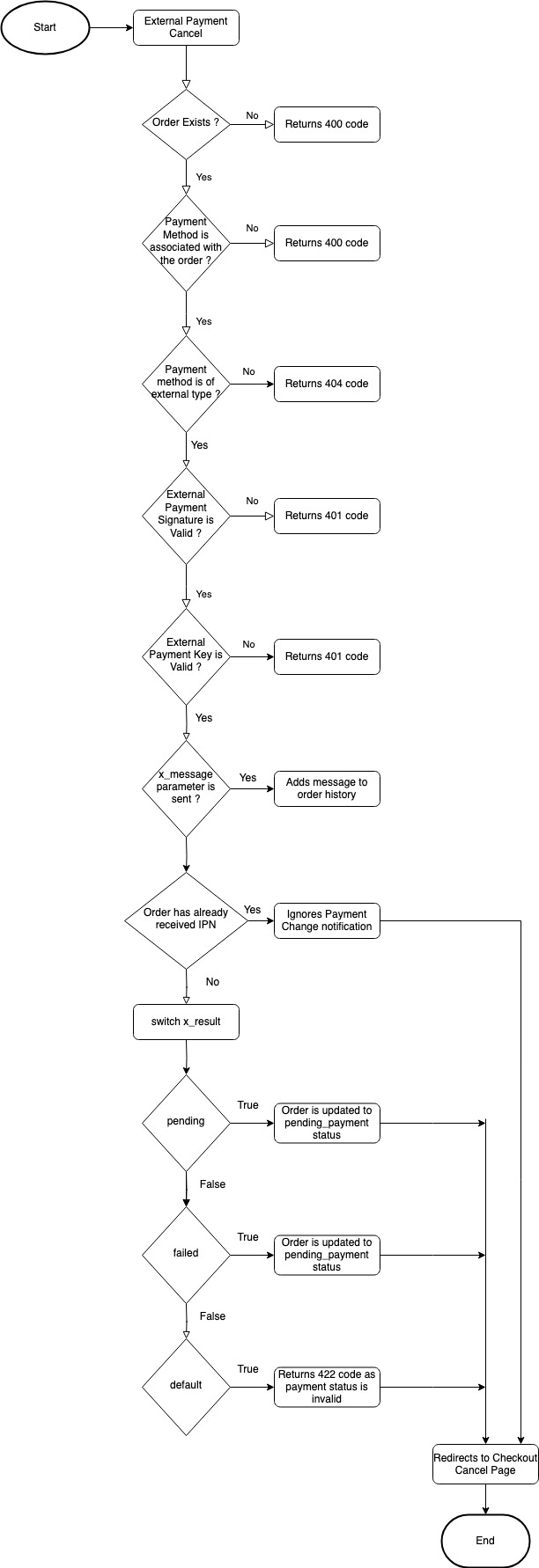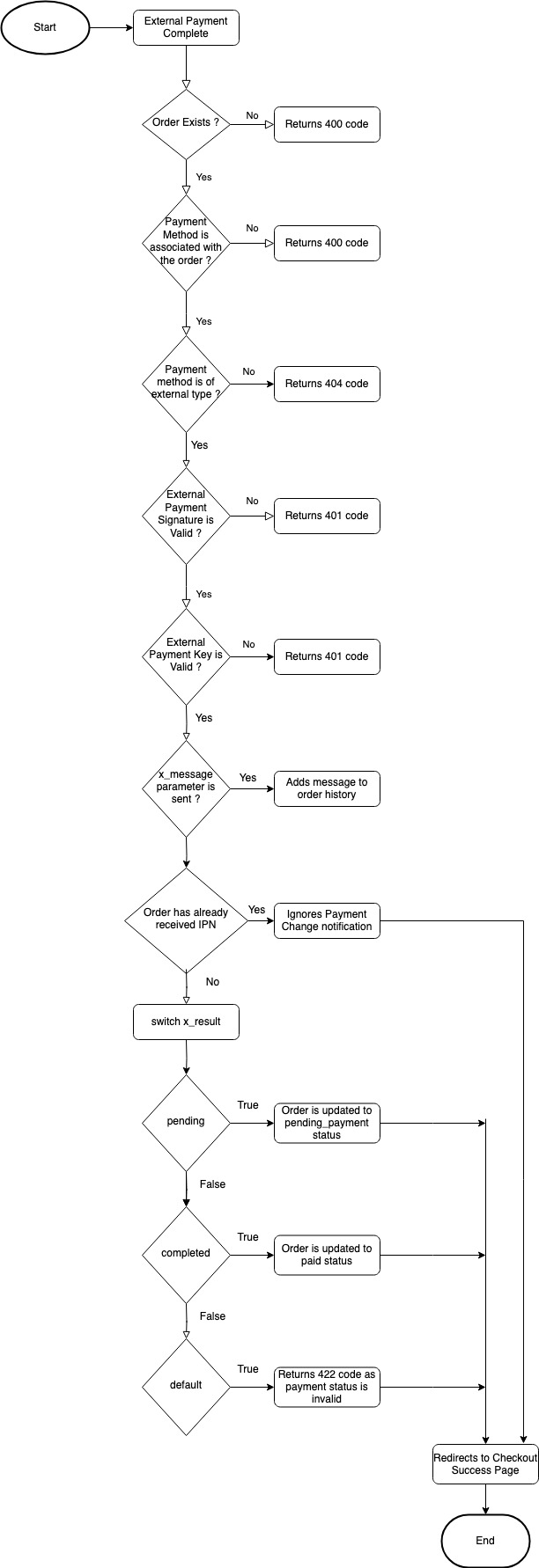How build a Jumpseller App
A Jumpseller App is an application that interacts with one or more online stores that use Jumpseller. The App can be loaded through an iframe insid...
Important: This is an advanced feature that allows you to connect any payment method with your store. Typically, an external web developer (or the payment gateway themselves) can do this integration.
A Jumpseller store can be integrated with any External Payment Gateway (EPG) of your choice. Any online payment service, with the ability to accept HTTP requests and capability to process online payment transactions, can be integrated with your Jumpseller store as an offsite payments method.
The customer places an Order on your Jumpseller store and selects your External Payment Gateway as a payment method.
The customer is redirected to your Payment method URL using a POST request with the following Request Parameters. Your Payment Gateway must verify the Signature before displaying the payment page.
GET) back to x_url_complete with all the required Response Parameters as query parameters, including the Signature
GET) back to x_url_cancel with all the required Response Parameters as query parameters, including the Signature
POST a callback asynchronously to x_url_callback with the same Response Parameters. This ensures that orders can be completed even in cases where the customer’s connection to Jumpseller is terminated by a network error. HTTP 200 status on a successful callback, otherwise you should perform at least 3 retries.After the customer fills the checkout details and places the order in your store, Jumpseller will make a POST request to the URL from your EPG settings with the following parameters:
| Parameter key | Description | Example |
|---|---|---|
| x_url_complete | URL to redirect after a successful transaction (GET). | https://demostore.jumpseller.com/checkout/external_payment_complete/1001 |
| x_url_callback | URL to provide notifications about transaction asynchronously (POST). | https://demostore.jumpseller.com/checkout/external_payment_notification/1001 |
| x_url_cancel | URL to redirect when the customer quits or cancels the payment (GET). | https://demostore.jumpseller.com/checkout/external_payment_cancel/1001 |
| x_account_id | Account identifier provided by the EPG. | 223504 |
| x_amount | Total value of the transaction. | 123.0 |
| x_currency | ISO code of the currency. | EUR |
| x_reference | Order number in your Jumpseller store. | 1001 |
| x_shop_country | ISO code of the Jumpseller store country. | PT |
| x_shop_name | Name of the Jumpseller store. | Demostore |
| x_description | Description of the transaction (optional). | \\nProduto:\\n1 x teste: 1.000 EUR\\nImposto: 23€ |
| x_signature | See “Signature” section | 3e3b0fa9b8e5e0309d8a4fd6ad00048548f8434873cfed2b42507ca9b580d053 |
| x_customer_first_name | Teste | |
| x_customer_last_name | Jumpseller | |
| x_customer_email | teste@jumpseller.com | |
| x_customer_phone | 912345678 | |
| x_customer_shipping_first_name | Teste | |
| x_customer_shipping_last_name | Jumpseller | |
| x_customer_shipping_city | Porto | |
| x_customer_shipping_address1 | Rua do Almada 123 | |
| x_customer_shipping_address2 | ||
| x_customer_shipping_state | Porto | |
| x_customer_shipping_zip | 4050 | |
| x_customer_shipping_country | PT | |
| x_customer_shipping_phone | 223456789 | |
| x_customer_billing_first_name | Teste | |
| x_customer_billing_last_name | Jumpseller | |
| x_customer_billing_city | Porto | |
| x_customer_billing_address1 | Rua do Almada 123 | |
| x_customer_billing_address2 | ||
| x_customer_billing_state | Porto | |
| x_customer_billing_zip | 4050 | |
| x_customer_billing_country | PT | |
| x_customer_billing_phone | 223456789 | |
| x_customer_taxid | Only sent for payment methods installed after 2022/07/19 | 1111111-1 |
All responses submitted to the provided asynchronous Callback URL are required to include the following parameters:
| Parameter key | Description | Example |
|---|---|---|
| x_account_id | Account identifier provided by the EPG | 223504 |
| x_amount | Total value of the transaction | 123.0 |
| x_currency | ISO code of the currency | EUR |
| x_reference | Order number in your Jumpseller store | 1001 |
| x_result | Status update for the transaction |
completed \ pending \ failed
|
| x_timestamp | UTC Time for when the transaction was finished | 2018-07-11T12:15:37Z (YYYY-MM-DDTHH:MM:SSZ) |
| x_message | (optional) Textual description of the result. Shown to Customer. | “The credit card could not be processed.” |
| x_signature | See “Signature” section. | 3e3b0fa9b8e5e0309d8a4fd6ad00048548f8434873cfed2b42507ca9b580d053 |
All requests and responses must include a field for account validation, x_account_id, which must match the Payment Method Key field in your payment settings. This is the account identifier that must be provided by your Payment Gateway account.
All requests and responses must include a signed field, x_signature, to test the integrity of the requests which is obtained using HMAC-SHA256.
In a Ruby environment, the following would get you a valid signature:
OpenSSL::HMAC.hexdigest(OpenSSL::Digest.new('sha256'), secret, result)
secret - the Payment Method secret field in your payment settings, this is a value which must be provided by your Payment Gateway account, and shared with Jumpseller.result - the request/response hash amassed in a single string of all key-value pairs that start with x_ prefix, sorted alphabetically, and concatenated without separators. Please make sure to exclude the field x_signature from this calculation when verifying any incoming request from the Jumpseller’s servers.Important notes:
x_message (& x_description) - any newline characters (‘\n’) must be properly escaped as (‘\\n’) before calculating the signature.x_amount - values are provided as Strings with decimals, even for rounded totals (e.g. 12345.0), so they are not converted unexpectedly.x_signature - the parameter should be excluded from the verification for Jumpseller requestsCreating a valid signature.
require 'openssl'
secret = 'external_payment_gateway_password'
hash = {
x_shop_name: 'Manchester Plant ', x_account_id: '223504', x_amount: '123.0', x_currency: 'EUR',
x_reference: '1001', x_result: "completed", x_timestamp: '2014-03-24T12:15:41Z',
x_message: "\\nProducto:\\n1 x Energise EDT 125 ML: 29.500 EUR\\nImpuesto: €6.785,00"
}
result = hash.sort.join
x_signature = OpenSSL::HMAC.hexdigest(OpenSSL::Digest.new('sha256'), secret, result)
=> "d5dbffd999d4cbf70de494b4eec410d68deb540de13ebf5cfc03903c78bbd496"
Making a GET request to external_payment_complete.
require "uri"
require "net/http"
url = URI("https://demostore.jumpseller.com/checkout/external_payment_complete/1026?x_signature=c6296d5a1b67c691e209a2023bee341f60d11b479f864b2016a8005a21888c64&x_shop_name=Manchester Plant &x_account_id=129785&x_amount=300.0&x_currency=CLP&x_reference=1026&x_result=completed&x_timestamp=2020-06-12T18:17:15.898Z&x_message=\\nProducto:\\n1 x Prueba de pago: $300")
https = Net::HTTP.new(url.host, url.port)
https.use_ssl = true
request = Net::HTTP::Get.new(url)
response = https.request(request)
If you show the response.read_body you will see the html from page that was redirected.
Making a POST request to external_payment_notification.
require "uri"
require "net/http"
url = URI("https://demostore.jumpseller.com/checkout/external_payment_complete/1026?x_signature=c6296d5a1b67c691e209a2023bee341f60d11b479f864b2016a8005a21888c64&x_shop_name=Manchester Plant &x_account_id=129785&x_amount=300.0&x_currency=CLP&x_reference=1026&x_result=completed&x_timestamp=2020-06-12T18:17:15.898Z&x_message=\\nProducto:\\n1 x Prueba de pago: $300")
https = Net::HTTP.new(url.host, url.port)
https.use_ssl = true
request = Net::HTTP::Post.new(url)
response = https.request(request)
=> #<Net::HTTPOK 200 OK readbody=true>
Creating a valid signature.
var crypto = require('crypto');
let body = {
"x_account_id": "1234",
"x_amount": "1000.0",
"x_currency": "EUR",
"x_reference": "1033",
"x_result": "completed",
"x_timestamp": "2020-06-12T18:17:15.898Z",
"x_message": "\\nProducto:\\n1 x Prueba de pago: $300"
}
let keys = Object.keys(body);
keys = keys.sort();
let toSign = '';
let query = '';
keys.forEach((key) => {
toSign += key + body[key];
query += encodeURIComponent(key) + '=' + encodeURIComponent(body[key]) + '&';
});
const secretKey = 'external_payment_gateway_password';
var signer = crypto.createHmac('sha256', secretKey);
var result = signer.update(toSign, 'utf8').digest('hex');
query += encodeURIComponent('x_signature')+"="+encodeURIComponent(result);
Making a GET request to external_payment_complete.
var request = require('request');
var options = {
'method': 'GET',
'url': 'https://demostore.jumpseller.com/checkout/external_payment_complete/3120?x_signature=be8d4df696d4e2c770b1890e67351b1f9be9f98cd94f421dfc7787c39f0e23c7&x_account_id=1988063&x_amount=1000.0&x_currency=EUR&x_reference=3120&x_result=completed&x_timestamp=2020-06-12T18:17:15.898Z&x_message=\\nProducto:\\n1 x Prueba de pago: $300'
};
request(options, function(error, response) {
if (error) throw new Error(error);
console.log(response.body);
});
If you show the response.body you will see the html from page that was redirected.
# !/usr/bin/env php
<?php
$secretKey = "external_payment_gateway_password";
$params = array( "x_shop_name" => "Manchester Plant ", "x_account_id" => "223504", "x_amount" => "123.0", "x_currency" => "EUR", "x_reference" => "1001", "x_result" => "completed", "x_timestamp" => '2014-03-24T12:15:41Z', "x_message" => "\\nProducto:\\n1 x Energise EDT 125 ML: 29.500 EUR\\nImpuesto: €6.785,00" );
$keys = array_keys($params);
sort($keys);
$toSign = "";
foreach ($keys as $key) { $toSign .= $key . $params[$key]; }
$sign = hash_hmac('sha256', $toSign, $secretKey);
echo $sign . "\xA";
// => d5dbffd999d4cbf70de494b4eec410d68deb540de13ebf5cfc03903c78bbd496
?>
In this section the flowcharts of the external payment gateway processes are presented to offer a more accurate representation of how the Jumpseller defines the different external payment method processes



All responses submitted to the provided Callback URL must include a x_result field with one of the following string values:
pending - The equivalent to Pending Payment in your Jumpseller Admin Panel, this action will add a message to the Order History without changing Order’s status.failed - The equivalent to Canceled in your Jumpseller Admin Panel, this action will cancel the order and change its status.completed - The equivalent to Paid in your Jumpseller Admin Panel, this action will change the order status.Once there are at least 2 Jumpseller stores using your Gateway that have processed at least 150 successful transactions each, you can request that Jumpseller lists your Gateway publicly for all merchants. If approved, your Gateway will be listed in Jumpseller’s Admin Panel and on Jumpseller’s public payment gateways page.
To request a public listing for your Gateway, email team@jumpseller.com with with the following details:
You will be published in the Admin Panel along other payment solutions, with your own logo. As shown in the image below:

For further announcements in newsletters and social media and other marketing activities please contact partners@jumpseller.com
Start your free 7-day trial. No credit card required.